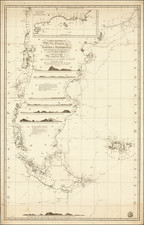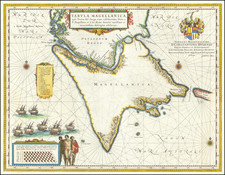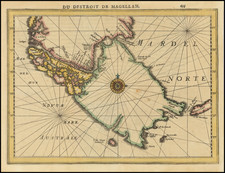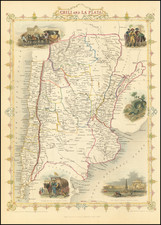An Ovalle Fragment Based Upon Fra. Gregorio de Leon's lost 1625 Map of Chile
One sheet of Alsono de Ovalle's landmark 6-sheet map of Chile, published in Rome in 1646.
The Ovalle map of Chile is a cartographic landmark of the highest order, matched only by its rarity. Unknown to major Latin American map scholars until the second half of 20th Century, the map is a bridge to lost earlier sources which until recently were largely unknown and unstudied.
The map covers a portion of southern Chile, centered on Isla Grande de Chiloe. Oriented with east at the top, the map extends from Isla Moca and Puren in the north to Madre de Dios Island in the south. A number of early colonial settlements are named, including Valdivia, Osorno, Castro, Calbuco, Villarica, and Nueva Imperial.
Along the top of the map, a series of Volcanoes is shown, with 9 named. Several indigenous Chilean Indians and a Llama are shown, along with the title cartouche.
Alonso de Ovalle's large map of Chile is without question the first and most important early map of Chile and one of the great cartographic works of South America from its colonial period and among the rarest. Known to survive in only 3 complete examples, it is a legendary rarity, whose full history was generally unknown to modern scholars until the work of Lawrence Wroth in 1959.
https://gallica.bnf.fr/ark:/12148/btv1b531882332/f1.item.r=ovalle.zoom
Ovalle's 6-sheet map of Chile was without question the most important map of the regions published in the first half of the 17th Century and the first detailed map of Chile based upon meaningful on the spot observations. Through the excellent work of Lawrence Wroth, Ovalle's map has been determined to be drawn from a now lost Mapa de Chile by Friar Gregorio de Leon, drawn in January 1625.
As noted by Wroth (see detailed excerpt below), the 6 sheet map was among other things the precursor to the small map of Chile which also appeared in Ovalle's Historica Relacion of 1646. It was also known to and used by mid 17th Century mapmakers, such as Nicolas Sanson, who specially cites the Ovalle map in his 1657 map of Chile, as does Guillaume De L'Ise in his : Carte du Paraguay du Chili . . . of 1703.
The present map sheet, comprising the lower center portion of the complete map, is a remarkable discovery. Based upon our research, there are no other known fragments of the map.
As noted by Wroth,
The cartographical importance of the map lies in its priority as a geographical description far exceeding in scope and detail those of De Laet, Herrera, Blaeu, Hondius, or Jansson, exceeding in fact all maps mentioned as preceding it in Medina's Mapoteca Chilena. . . Its wealth of place names, its indications of mines, of mission stations, of cities and towns, of volcanoes, of rivers; its recognition and marking of the River Bio Bio as the boundary between the Spaniard and the Araucanian tribes (the Rhine of this particular contact between Latin and native race)-all these and many pertinent and revealing legends provide for us one of the most informative American maps of its period.
The question arises as to whence came the geographical data which went into the making of this map. Certainly, the reply must be, from no well-known or easily available source. Mapas Españoles de America contains no manuscript map from Spanish archives upon which it might have been based. Francisco Vindel neither reproduces nor refers to a printed map which could be regarded as its prototype, and, as we have intimated, examination shows that the maps of De Laet, Herrera, Hondius, Blaeu, and Jansson could not have been its inspiration.
One suggestion may be made as to a prototype which is at least worth consideration. In putting forth this suggestion more questions are raised, unhappily, than are answered. It may be, however, that what is now to be said will lead to the discovery of a source of Chilean geographical knowledge today lost to view.
In the address "Ad Lectorem" [the text box at the top of the map sheet offered here] speaking of the mineral riches of the land, Ovalle writes: "F. Greg. de leon in sua mappa laminam auream regionem hanc appellat". [In a different section of the map, Ovalle] mentions again the wealth of the country in gold, supporting the evidence of De Laet in this particular by the statement, "cui subscribit F. Greg. de leon dum in sua chilensi geographia ait tot esse in hac regione sodinas auri ut satius sit lamina aured eum dicere quam singulas numerare". With curiosity stirred by these references to an unknown mapmaker or geographical writer, we sought for references to Gregorio de Leon in modern works of bibliographical or biographical reference. The search was in vain. Recourse to earlier works, however, was more fruitful. In the Bibliotheca Hispana sive Hispanorum of Nicolas Antonio, edition of 1672, is found this entry:
F. Gregorius de Leon, Franciscanus: Chilensis regni Americae Chartam Geographicam formavit, elogiumque
The title as given by Antonio, not only the earliest but the most explicit we have found, seems to inform us that the lost work we seek was a combination of map and text, possibly a text of geographical description The Franciscan's work was published, probably, as we shall see, between 1625 and 1629. Though it was not entered in the Leon Pinelo Epitome of 1629, we find in the greatly expanded eighteenth-century edition of that work the following entry:
Fr. Gregorio de Leon, Franciscano, Mapa de Chile, que dedico al Presidente Don Luis Fernandez de Cordova, Senor
del Carpio, segun Ovalle, en su Relacion, fol. 9. 28. i 61.Pursuing the indications given in this entry we turn to the text of the Ovalle Relacion, where on page 9, the author, in speaking of the mineral wealth of the country, wrote as follows:
*Sy assi dixo Fray Gregorio de Leon en su mapa de Chile, y otros autores, que son tantas estas minas en este
Reyno, que mas valia llamar esta tierra una plancha, o lamina de oro, que ponerse a contar sus minas por ser
inumerables."On page 28, commenting upon the men with tails, Ovalle wrote:
". . . una nacion de Indios, que dizen, nacen alli con cola, como lo refiere en su Mapa Fray Gregorio de Leon
citado arriba."And finally on page 61 is the statement:
"Fray Gregorio de Leon de la orden del Serafico P. san Francisco en el mapa de Chile que dedico al Presidente
D. Luis Fernandez de Cordova senor del Carpio, dize que ay arbol de estos tan gruesso, que a penas podran
rodear su tronco dos fogas, que Rlaman sobre cargas, y cada una tiene seis bragas. . . "A further reference to the Franciscan friar's Mapa is found in the bibliography attached to the Bologna, 1787, edition of Juan Ignacio Molina, Saggio sulla Storia civile del Chili, where, page 326, occurs the entry: "Leon (Fr. Gregorio) Mapa de Chile impr."
This entry, confirming our belief that the Franciscan's Mapa was a printed work, is found also in the bibliography, page 380, at the conclusion of the "Parte Segunda" of the Spanish version of Molina's work, bearing the title Compendio de la Historia civil del Reyno de Chile (Madrid, 1795).16 In the "Primera Parte" of the Spanish version, pages VII-VIII of the "Prefacio del Autor", the name of Gregorio de Leon is mentioned in connection with the "historias" or "relaciones" of Ovalle, Santiago Tesillo, and Melchor de Aguila, and an anonymous Italian compend. In this passage the author, as does Nicolas Antonio in the quoted passage, seems to speak of the work of Gregorio de Leon as a book, even though in the bibliography of his later section he calls it Mapa. It is understood, however, that "mapa" in Spanish usage can mean a table or synopsis, a secondary meaning of the word comparable to the English usage of "chart" as "a sheet bearing information of any kind arranged in graphical or tabular form". Though this meaning of the word is not noticed in the Diccionario of the Real Academia Espafiola, it is easy to point to Spanish works in which "mapa" is used in the title of a sheet of tabulations or of a book of the same character. Though this use of the word must be given consideration, we are inclined to disregard it and to take as literal truth the substance of the Antonio title first quoted, namely, that Gregorio de Leon constructed a geographical map of Chile and added to it a brief text. Whatever the exact nature of it may have been, we suggest that the work of Gregorio de Leon was a main source of Ovalle's two maps of Chile, rather than certain "mapas publicados en Holanda" casually and rather vaguely mentioned by Medina.
The Mapa de Chile by Friar Gregorio de Leon was composed at some time after January, 1625, when its dedicatee, the Presidente Don Luis Fernandez de Cordova, was appointed to his office in Chile, and the later months of 1629 when Don Francisco Lazo de la Vega appears as successor to Don Luis as "presidents, governador y capitain general'".
Rarity
The 6 sheet map is an extreme rarity. It was unknown to Francisco Vindel in his Mapas de America en los Libros Españoles and at the time of Lawrence Wroth's article, it was known to survive in 3 examples (Bibliotheque National de France (separate map) and John Carter Brown Library (bound into the Huth-JCB copy of Ovalle's Historica Relacion.
We are unaware of any complete copies of the map or map fragments to appear on the market since the sale of the Huth copy was sold to John Carter Brown over 100 years ago.
The following is excepted from Lawrence Wroth's Alonso de Ovalle's Large Map of Chile, 1646
Alonso de Ovalle, author of the Historica Relacion del Reyno de Chile. . . was born in Chile in 1601, the elder son of Don Francisco Rodriguez del Manzano y Ovalle and Dofia Maria Pastene de Astudillo y Lantadillo. The father is described by Jose Toribio Medina, the Chilean historian, as a Spanish captain, originally of Salamanca, who went to Chile early in the year 1600, sent thither in charge of a detachment of soldiers by the Governor of Buenos Aires. . . .
He was not pleased when his elder son and heir [Alonso] joined the Society of Jesus . . . . One day at the age of seventeen this lad, when returning with his younger brother from a local fiesta, chose . . . a road which led past the convent of the Jesuits in Santiago. At the doorway of the convent the boy Alonso dismounted, and saying farewell to his brother, directed him to proceed homeward with the horses. Without other ceremony than this he entered the cloister and began his novitiate. "For I am come to set a man at variance against his father"-thereafter no words or actions of Don Francisco availed to constrain either the boy or the Jesuits who had received him.
The young man's zeal and devotion to the Faith and the Society led him in time to a successful career as missionary to the Indians and as rector of the "colegio seminario". Prominent in the local affairs of the Society, he was sent abroad early in 1641 as "procurador" of the Chilean Jesuits, a mission which detained him in Spain and Italy until the year 1650. He was never again to see Santiago. He died in May, 1651, at Lima, in the course of his journey homewards.'
* * *
. . . [T]he Historica Relacion, a substantial work which he succeeded in publishing in Rome in 1646 in both Spanish and Italian versions. The book in both editions is extraordinary for its plenitude of illustrations, chiefly woodcuts of Jesuit establishments and plans of harbors, and for the presence in it of a lively and interesting map of Chile. The Spanish version contains a rich addition of twenty-one copperplate portraits of Chilean worthies, nine "Gubernatores Perillustres" and twelve "Invicti Duces". . . . The Ovalle work is the earliest history of Chile worthy of the name, a composition of excellent quality and of great interest to a reader who does not allow himself to be prejudiced by the author's partisan zeal for his Society or his naive and occasionally intrusive piety.
But, whatever criticism may be made of the Historica Relacion, it presented to its contemporaries a full account of the natural features, the products, and the aboriginal races of the stern and beautiful land with which it was concerned. Its narrative concludes with an account of the peace made with the Araucanian Indians by the Marques de Baides in 1641. Though it proved to be a respite only, that treaty ended for a few years a century of harsh, heroic, and inconclusive conflict. Out of that long war had come an unexpected flower, the notable Spanish epic, La Araucana, which Alonso de Ercilla y Zu'n-iga published in its
first part in 1569.











![Primer Plano de Varios Puertos Del Estrecho de Magallanes, Levantados El Ano De 1788 [Close-up of Several Ports of the Strait of Magellan, Surveyed in the Year 1788.]](https://storage.googleapis.com/raremaps/img/small/92296.jpg)


